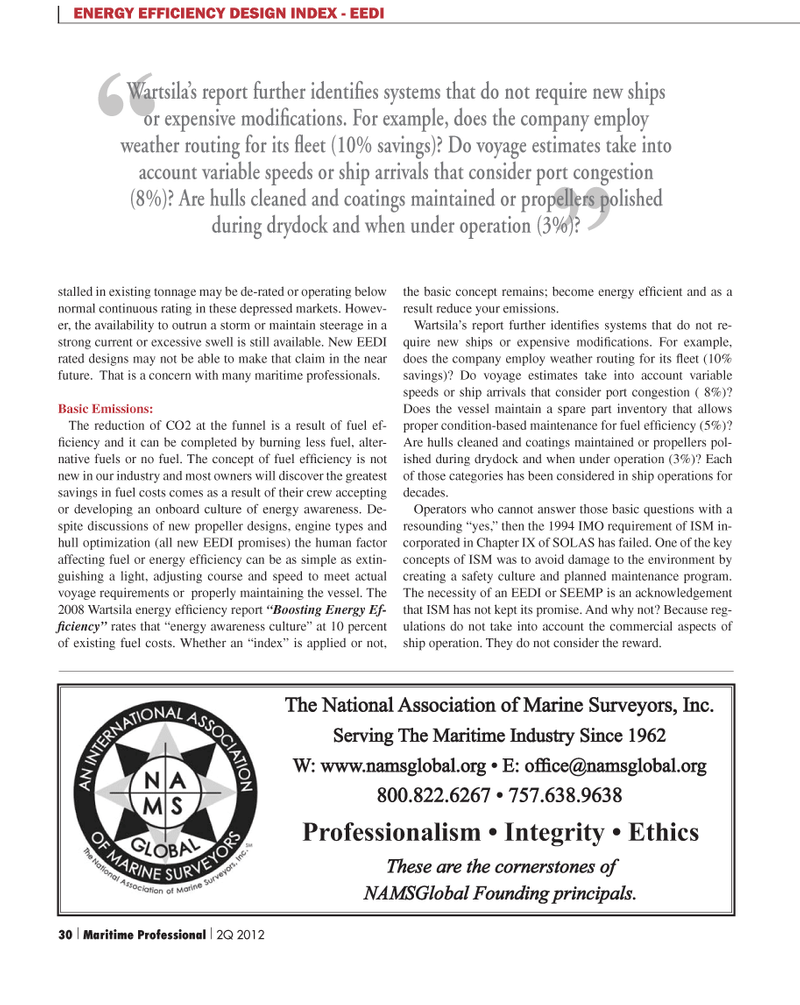
Page 30: of Maritime Logistics Professional Magazine (Q2 2012)
Maritime Risk
Read this page in Pdf, Flash or Html5 edition of Q2 2012 Maritime Logistics Professional Magazine
stalled in existing tonnage may be de-rated or operating below normal continuous rating in these depressed markets. Howev- er, the availability to outrun a storm or maintain steerage in a strong current or excessive swell is still available. New EEDI rated designs may not be able to make that claim in the near future. That is a concern with many maritime professionals.
Basic Emissions:
The reduction of CO2 at the funnel is a result of fuel ef- fi ciency and it can be completed by burning less fuel, alter- native fuels or no fuel. The concept of fuel effi ciency is not new in our industry and most owners will discover the greatest savings in fuel costs comes as a result of their crew accepting or developing an onboard culture of energy awareness. De- spite discussions of new propeller designs, engine types and hull optimization (all new EEDI promises) the human factor affecting fuel or energy effi ciency can be as simple as extin- guishing a light, adjusting course and speed to meet actual voyage requirements or properly maintaining the vessel. The 2008 Wartsila energy effi ciency report “Boosting Energy Ef- fi ciency” rates that “energy awareness culture” at 10 percent of existing fuel costs. Whether an “index” is applied or not, the basic concept remains; become energy effi cient and as a result reduce your emissions.
Wartsila’s report further identifi es systems that do not re- quire new ships or expensive modifi cations. For example, does the company employ weather routing for its fl eet (10% savings)? Do voyage estimates take into account variable speeds or ship arrivals that consider port congestion ( 8%)?
Does the vessel maintain a spare part inventory that allows proper condition-based maintenance for fuel effi ciency (5%)?
Are hulls cleaned and coatings maintained or propellers pol- ished during drydock and when under operation (3%)? Each of those categories has been considered in ship operations for decades.
Operators who cannot answer those basic questions with a resounding “yes,” then the 1994 IMO requirement of ISM in- corporated in Chapter IX of SOLAS has failed. One of the key concepts of ISM was to avoid damage to the environment by creating a safety culture and planned maintenance program.
The necessity of an EEDI or SEEMP is an acknowledgement that ISM has not kept its promise. And why not? Because reg- ulations do not take into account the commercial aspects of ship operation. They do not consider the reward.
The National Association of Marine Surveyors, Inc.The National Association of Marine Surveyors, Inc.
Serving The Maritime Industry Since 1962Serving The Maritime Industry Since 1962
W: www.namsglobal.org • E: ofg191 [email protected] www.namsglobal.org • E: ofg191 [email protected] 800.822.6267 • 757.638.9638800.822.6267 • 757.638.9638
Professionalism • Integrity • Ethics
These are the cornerstones of These are the cornerstones of
NAMSGlobal Founding principals.NAMSGlobal Founding principals.
The National Association of Marine Surveyors-NAMS.indd 1 5/1/2012 4:46:37 PM “ ”
Wartsila’s report further identifi es systems that do not require new ships or expensive modifi cations. For example, does the company employ weather routing for its fl eet (10% savings)? Do voyage estimates take into account variable speeds or ship arrivals that consider port congestion (8%)? Are hulls cleaned and coatings maintained or propellers polished during drydock and when under operation (3%)?
ENERGY EFFICIENCY DESIGN INDEX - EEDI 30 | Maritime Professional | 2Q 2012
MP #2 18-33 NEW STYLES.indd 30 5/4/2012 5:05:27 PM

 29
29

 31
31
